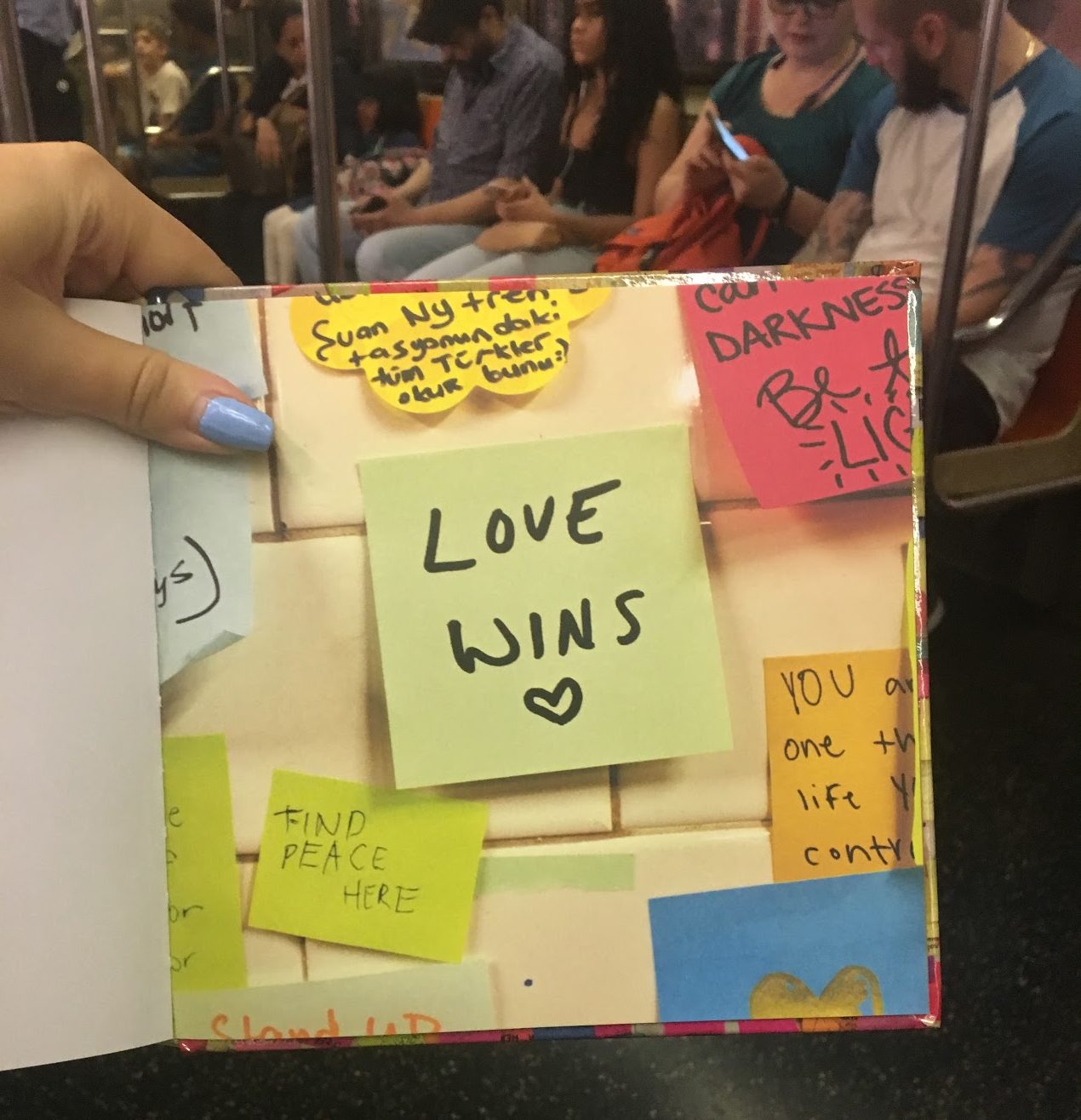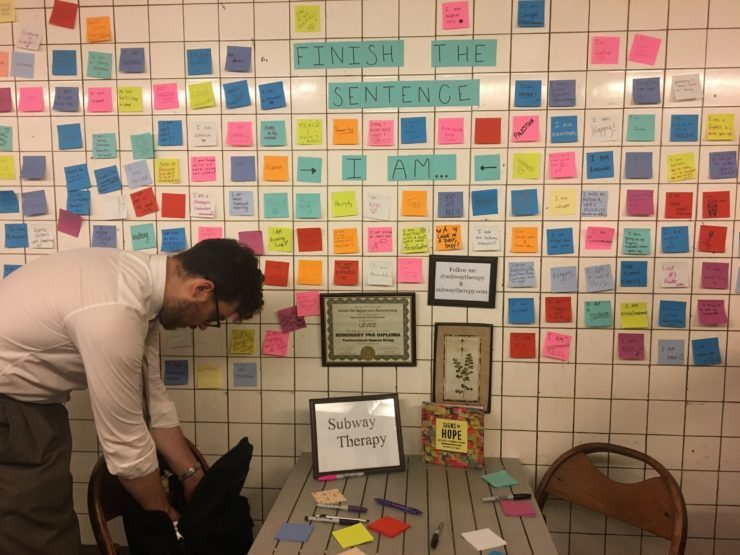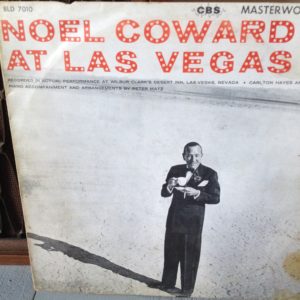
Some of the Subway Therapist's notes.
Loss was too much with us this week, as we learned of yet another mass shooting that beggars the imagination. And it’s a theme of this week’s posts, too. In India, The New York Times’ Ellen Barry writes about a man who murders his wife and gets away with it (until her story was published, that is). And in a Guardian piece, we descend into the obsession of a father whose son was murdered. But we also wanted to offer a bit of hope, from the “Subway Therapist” of New York, whose sticky notes provide succor to anxious commuters. Oh, and a little Noël Coward can’t hurt, either.

Jahiruddin Mewati, the chief of Peepli Khera, a small village in Uttar Pradesh, presided over a particularly Indian form of justice.
Ellen Barry and “How to Get Away With Murder in Small-Town India.” This absolutely wonderful story was Barry’s last piece out of India after a four-year tour of duty here. Her editor encouraged her to use first person, which she employs to softly humorous and cinematic effect. In fact, as contributor Julia Shipley says, it’s one of the triumphs of the piece: By using first person, Barry serves as a stand-in for “the interloper” in India, be it the colonial imposer or the foreign correspondent. “If you are using the first person, you almost by necessity need to be a character,” Barry says. “Being a rich white person in rural India, or any place that poor, is a strange, uncomfortable feeling much of the time. So I suppose I wanted to explore that.”
The soundtrack: “Barbarism Begins at Home,” by the Smiths. This is a textbook example of why the Smiths were so good: the jangly, poppy guitars of Johnny Marr in such stark contrast to Morrissey’s atonal voice singing lyrics like this one: “A crack on the head/Is what you get for not asking/And a crack on the head/Is what you get for asking.”
One Great Sentence
“We all live in a house on fire, no fire department to call; no way out, just the upstairs window to look out of while the fire burns the house down with us trapped, locked in it.”
Tennessee Williams, “The Milk Train Doesn’t Stop Here Anymore.” Read why we think it’s great.

Subway Therapy's Levee in front of his sticky-note collage in the 14th Street station.
New York’s “Subway Therapist” and his collage of a city’s hopes and fears. For a year now, Matthew “Levee” Chavez has been a bright spot (literally) in the subway stations of New York. He invites commuters to express their thoughts on his neon sticky notes, and now has collected the results in a book. Realistically, contributor Jasmine Bager writes, Levee knows that this communal art experience won’t move mountains or shift perspectives. But he aims to provide a colorful space in which New Yorkers can slow down and appreciate the simple things in life—like using an inexpensive colorful piece of paper, a pen and a thought.
The soundtrack: “Therapy,” by Mary J. Blige. “Why would I spend the rest of my days unhappy/Why would I spend the rest of this year alone/When I can go therapy/When I can go therapy two times a day?” Now this is a postmodern soul song. A great groove, and a great voice.
What I’m reading online: “The father who went undercover to find his son’s killers,” by Matthew Bremner for the Guardian. This is a nuanced and complex look at a man lauded as a hero in Spain after he tried to hunt down the men who killed his son. Yes, there is bravery. But there is also obsession, and narcissism, and the wreckage of a family already damaged by loss.
“One Last Thing Before I Go,” from “This American Life.” In this week filled with loss of a magnitude that’s hard to absorb, I decided to listen again to the incredibly moving first half of this episode, “Really Long Distance,” by Miki Meek. It’s about the old-fashioned phone booth that’s been installed in one of the Japanese towns hardest-hit by the 2011 tsunami. People go in to “call” their dead and missing loved ones, and if you can listen to this without crying, you win the G. Gordon Liddy tough-guy award. Like this moment: “She’s dialing the phone number for her old house in Otsuchi, the last place she knew to reach her husband. Then Kikue just stands in the booth in silence, holding the phone to her ear. Sometimes she fidgets around and tilts her head up, and concentrates on the ceiling, the same way I do when I want to cry but I’m trying hard not to. It doesn’t work.”
The best literary journalism about the scourge that is the gun epidemic. Sadly, this week of posts from earlier this year is relevant again. Here’s the weekly newsletter with links to all of them.
 What’s on my bedside table: “The Light of Day,” by Graham Swift. I’m a big fan of Swift’s, especially “Last Orders.” This one has a compelling plot, and some lovely insights, including this one, which I experienced recently but couldn’t describe as eloquently: “Like the photo of yourself as a kid, staring at you from another world, another planet. Was that me, really me? And the kid stares back as if he doesn’t know you either, never seen you before in his life.” But the staccato cop-speak of the narrator isn’t clicking with me yet.
What’s on my bedside table: “The Light of Day,” by Graham Swift. I’m a big fan of Swift’s, especially “Last Orders.” This one has a compelling plot, and some lovely insights, including this one, which I experienced recently but couldn’t describe as eloquently: “Like the photo of yourself as a kid, staring at you from another world, another planet. Was that me, really me? And the kid stares back as if he doesn’t know you either, never seen you before in his life.” But the staccato cop-speak of the narrator isn’t clicking with me yet.
 What’s on my turntable: “Noël Coward at Las Vegas,” Noel Coward. I thought that in this awful week in Las Vegas, we could think of a happier time there. A charming Englishman sips tea in a bespoke suit, a boutonniere on his lapel, a cigarette holder sharing his palm with a saucer. The music-hall spirit of his music (could he do everything?) keeps the feel-good vibe going. And then there’s this, on the liner notes: “With all of the crackling, electric, sophisticated output of Mr. Coward, he does have, sentimental though it might seem, what we are told these days we must have a ‘lot’ of — heart.”
What’s on my turntable: “Noël Coward at Las Vegas,” Noel Coward. I thought that in this awful week in Las Vegas, we could think of a happier time there. A charming Englishman sips tea in a bespoke suit, a boutonniere on his lapel, a cigarette holder sharing his palm with a saucer. The music-hall spirit of his music (could he do everything?) keeps the feel-good vibe going. And then there’s this, on the liner notes: “With all of the crackling, electric, sophisticated output of Mr. Coward, he does have, sentimental though it might seem, what we are told these days we must have a ‘lot’ of — heart.”
If you want to chat about storytelling (or music), I’m Storyboard editor Kari Howard, and you can reach me at editor@niemanstoryboard.org. Or you can find me at @karihow on Twitter.


